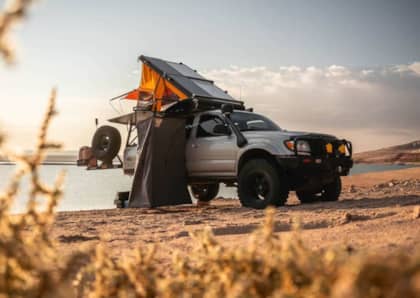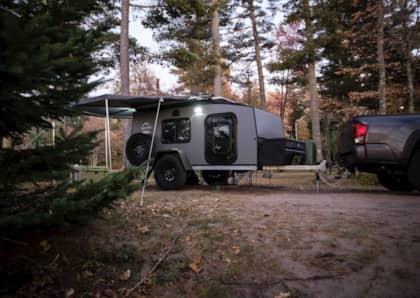OEM Overlanding Models vs Aftermarket Upgraded Base Models: Who Wins?
It seems like the list of OEM overlanding vehicles is growing longer by the day. With so many different brands trying to lure adventure-seeking buyers into showrooms, we decided to compare some of the most popular factory overland choices with what can be achieved with the aftermarket to see which choice is best for those just getting started on the trail.

It turns out that there's more than one answer when comparing OEM overlanding models versus aftermarket upgraded base models—especially considering the wide range of stock hardware that's currently on the market.
The Different Tiers Of OEM Overlanding
Factory-built off-road vehicles are nothing new, but the focus on overlanding is a much more recent development. The key difference between these two ruggedized model line-ups is that overland editions tend towards lighter all-terrain capability rather than hardcore, go-anywhere gear in a bid to better balance daily driving with the capability to leave the asphalt behind. That being said, even within the world of OEM overlanding there are different degrees of vehicle prep.

Honda's TrailSport series provides the bare minimum for what buyers can expect when shopping for a factory overlanding option. Redesigned bumpers, a wider track, slightly more aggressive rubber, and for the Honda Pilot TrailSport (but not the somewhat smaller Honda Passport TrailSport), an extra inch of ground clearance (bringing it to 8.3 inches) and a beefier torque-vectoring rear differential.

The Ford Timberline package, which is currently only offered on the full-size Explorer SUV, steps up with a few extra features past what Honda has to offer. It provides tow hooks, a suspension lift that's good for 8.7 inches of ground clearance, knobby tires, skid plates, and a Torsen limited-slip differential. Bumpers are also tweaked to reduce overhangs front and rear.

Subaru arguably kicked off the recent factory overland craze with its Wilderness line of crossovers, which so far includes the popular Subaru Outback Wilderness as well as the Subaru Forester Wilderness and the more recent Subaru Crosstrek Wilderness. It presents the most complete set of upgrades available for OEM overlanding among SUVs.

The standard Wilderness package gives drivers a bit more ground clearance (between 9.2 and 9.5 inches, depending on the model, versus 8.7 inches for non-Wilderness models), suspension tuning intended to better tackle rough terrain, a skid plate up front, aggressive all-terrain tires, and additional drive modes for the all-wheel drive system. In terms of appearance, the Outback, Crosstrek, and Forester come with revised front and rear bumpers to improve approach and departure angles. The Wilderness models further add more aggressive gearing, moving to a 4.11:1 final drive ratio.

Toyota finds itself balancing right at the edge of hardcore off-roading and overlanding appeal with the upcoming Toyota Tacoma Trailhunter edition. The truck's suspension was designed by aftermarket upfitters ARB and makes use of 2.5-inch monotube shocks (with external reservoirs at the rear) from Old Man Emu. With a 2 inch front lift (and a 1.5 inch lift at the rear), a disconnecting swaybar up front, an electronically-locking rear differential, and huge 33-inch tires, the Trailhunter pickup is on another level in terms of off-roading capability as compared to most overlanding fare. It also offers full skid plating and rock rails, as well as an ARB steel bumper at the back (and recovery hooks), and even a snorkel and an in-bed air compressor.
What The Aftermarket Brings To The Table
Right off the bat, it's clear that the Toyota Tacoma has the deepest aftermarket of any of the vehicles listed above. Consider, too, that the Trailhunter's gear is all provided in partnership with ARB, and it's possible to equip a base model Tacoma with almost any of the features found with the overlanding model.

Some of the other entries here are harder to shop for when it comes to putting together a dedicated light off-roading build. For vehicles like the Honda Passport, Honda Pilot, and Ford Explorer Timberline, it's not difficult to source skid plates, or aftermarket wheels in the 18-inch range that open up a number of all-terrain tire options such as the Nitto Ridge Grappler or the Recon Grappler A/T.

Fitting larger tires, however, can require modification in terms of suspension and body. Lift kits are available for vehicles like the Passport and the Explorer (with Traxda, for example, offering options for each), but you'll be left to do your own engineering when it comes to making the rolling stock and springs and shocks play nice together. For some vehicles, such as the Passport, you may even need to relocate the front axles in order to avoid rubbing at full lock regardless of whether you have a lift kit installed or not.

The Subaru Outback, Crosstrek, and Forester already come with enough ground clearance to mount larger tires (such as the Nitto Nomad Grappler), which saves time, money, and hassle. They also avoid the larger 20-inch wheel sizes that are common on other SUVs, hovering around the 17-inch to 18-inch range which improves tire choice overall. With strong support from aftermarket vendors, skid plates, tire carriers, and other accessories are out there to match nearly every add-on feature found in the Wilderness playbook, up to and including off-road bumper replacements.

Where you'll have more trouble matching factory overlanding spec with aftermarket gear is with the mechanical and electronic aspects of the drivetrain. You can't easily add drive modes, nor cheaply upgrade to torque-vectoring or limited-slip differentials, and swapping in a new final drive ratio and reprogramming the vehicle's ECU to take advantage of it can quickly get expensive.

It's also worth considering the engine of your overlander itself. If you're sticking with a base model, you're giving up the additional torque provided by models like the Timberline and the Wilderness, each of which installs the best possible drivetrain right out of the box. This can be an issue when trying to turn larger wheels with less power than what you could have accessed from the factory overlanding option.
Which Path To Travel?
There are two major advantages when choosing an OEM overlanding solution. The first is the engineering that goes into the entire setup—you don't have to guess at parts fitment, or hope that your tires are a good match for the transmission gearing in your vehicle, because the brand in question has already spent the time required to test out the package and get those answers for you. Then of course there's the warranty coverage, which ensures that you won't be throwing protection out the window when a service manager at the local dealership blames your mods for whatever problem you're having diagnosed.

On the aftermarket side, you have more freedom to only upgrade the parts of the vehicle that you need to improve, whether that's better underbody protection, increased traction from all-terrain tires, or improved ground clearance. That can help save you money versus a factory overlander that covers more bases (and expects you to pay for all of them). The flipside of that is you'll have to do the legwork to make sure that the components you do plan to buy actually exist and will all get along when installed alongside each other. You'll also have to be ok with forgoing some of the more advanced drivetrain features found in the showroom model, and potentially accept lower horsepower and torque from the base engine.











